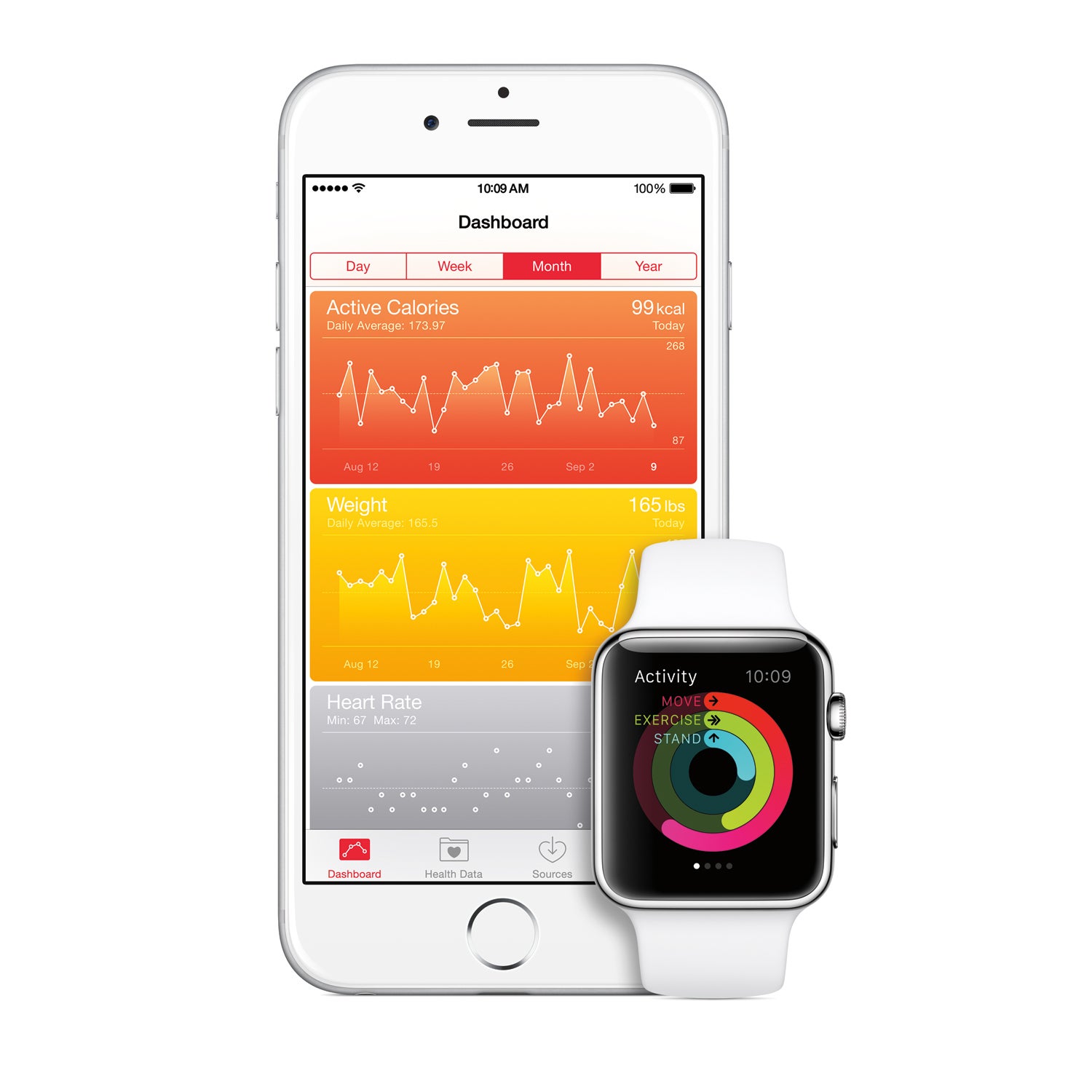After months (years?) of rumors,—and it’s a doozy. The hype volume about the Apple Watch is currently cranked up to 11—revolutionary user interface! replaces your credit cards! sends squiggly drawing to your friends!—but exactly how it will affect the exploding world of health and fitness wearable tech is unclear. Does the Apple Watch massively disrupt the market for fitness-tracking wearables? The answer is no. And also yes.
To evaluate how the Apple Watch compares with the current crop of tracking and training devices, let’s start with the hardware. The watch comes in two sizes, small and large, and the Sport Collection features a 60 percent stronger alloy case and rubber wrist strap. The watch has a lovely touch display and a knob on the side that you can use to zoom in and out and scroll through pages. It’s classic Apple: reinvent the category by refining the user experience. But it’s what’s on the inside that counts. Under the hood are an accelerometer, an optical heart-rate monitor, and a Bluetooth radio that connects the watch to your iPhone (and lets it leverage the phone’s GPS, Wi-Fi, and 4G antenna).
By comparison, all-day wristband activity trackers like and have accelerometers, which sense motion (in the case of these devices, steps taken and sleep disturbances) but no heart-rate monitor. , a more specialized fitness device engineered to record workouts, offers an accelerometer, wrist heart-rate monitoring, and GPS tracking, but like the Fitbit and Up, it needs to be synced to a phone to upload data to apps. Like the TomTom, the —an upmarket lifestyle watch—features wrist-based heart-rate monitoring and can measure skin temperature and perspiration. The upcoming Timex One GPS+, a rugged, waterproof device for hardcore athletes, has an accelerometer, GPS, and, most impressively, 3G connectivity, meaning it requires a data plan but can operate independently of your phone—you can upload data and even send and receive texts. (It can also be paired with a chest-strap heart-rate monitor.)
So, at first glance, it seems that there’s no fitness-tracking hardware in the Apple Watch that’s not already inside other devices. As with the original iPhone, Apple has refined features found in other products and packaged them in an alluring device. But that explanation underplays what makes this device so exciting: the unpredictable health dividends of mass adoption and developer-ready software paired with an awesome interface.
When the iPhone was introduced in 2007, it was, a “beautiful and breakthrough handheld computer.” But much of what makes the phone so powerful today—the apps—was nonexistent. It wasn’t until 2008 that Apple began to support third-party applications and the phone’s true promise was unlocked. We’re excited to see what developers can do to make the watch a tool for high-performance training, but Apple has already upended the fitness landscape in ways few have noticed. With its watch, Apple has synthesized the two most disparate trends in fitness-tracking devices: everyday wellness and training.
That may not sound revolutionary, but it is. Companies like Garmin and TomTom build devices for athletes. Their watches and computers sync with power meters and other sensors designed to give performance readings; they’re not for wearing to work or to the bar. Meanwhile, wearables like Fitbit are designed to help encourage the everyman to stay more active.
: Activity tracks how often and how well you move; Workout is a more performance-oriented app; and Health stores your data and provides opportunities for cross-app communication.
Let’s start with Activity, an elegant app that tracks and promotes three fundamental aspects of physical life: overall movement, exercise, and standing time. In a series of concentric rings, Activity displays your daily progress toward goals for each of these metrics. Your daily mission? Complete the circle. To do so, you’ll need to stand for at least one minute in each of 12 hours during a day; if you don’t, you’ll get a reminder. You also have to complete a half-hour of vigorous exercise—taking a brisk walk, at a minimum—and burn an Apple-determined number of calories.
For endurance athletes, this is basic stuff. We know we need to sit less, move more, and train harder. But the average American doesn’t. And as studies have repeatedly shown, .
Once Activity gets you hooked, Workout teaches you how to train. Whenever you’re running, walking, or biking, the app shows real-time stats on pace, calories, distance, and time. It also motivates you to go harder by suggesting goals based on your workout history (you ran 30 minutes yesterday; today you’re ready for 35), providing reminders as you train (you’re halfway through your run, congrats!), and even bestowing badges when you’ve hit a personal best.
Many devices on the market do this already. Few, Apple hopes, will do it as well or as seamlessly. And it’s almost certain that no fitness device will have the tremendous reach of the Apple Watch. The more wrists it appears on, the more people will have a daily reminder to get up and keep moving.
This brings us to calories burned, weight, heart rate, blood sugar, cholesterol, and anything else another app or fitness tracker has recorded. Health also serves as a control center, limiting the data available to other apps, and a conduit to Apple hinted at the possibilities on its site: “You can allow the data from your blood-pressure app to be automatically shared with your doctor. Or allow your nutrition app to tell your fitness app how many calories you consume each day.”
As the wearable-tech market continues to grow, as developers create new apps, and as Apple adds more features to the watch, a totally integrated future becomes plausible. Your watch wakes you up at just the right time, keeps you standing enough—but not too much to tire out your legs—during the day, selects your evening run, and rewards your effort with a beer purchased through Apple Pay. It’s a vision that wasn’t imaginable even a few days ago, or achievable on any other device currently available.
While all this sounds pretty promising, the Apple Watch won’t be available until Spring 2015, and there’s still a lot we don’t know: Will the heart-rate function monitor you continuously (like the fitness-tracker or the ) or only at select times? Obviously, we hope it’s the former. Also, it’s rumored that Apple is still unhappy with the device’s battery life. Will the watch even make it through an entire day?
There’s really only one thing we’re certain of: Apple is going to sell a zillion of these things. Most of them will go to average Joes, not hardcore athletes, but the latter stand to benefit from the massive influx of users, too—and not just because health premiums are likely to go down. Big picture: we’re going to have tons of info to compare health across millions of people. Think of Strava, but for far more people and with a lot more data.



